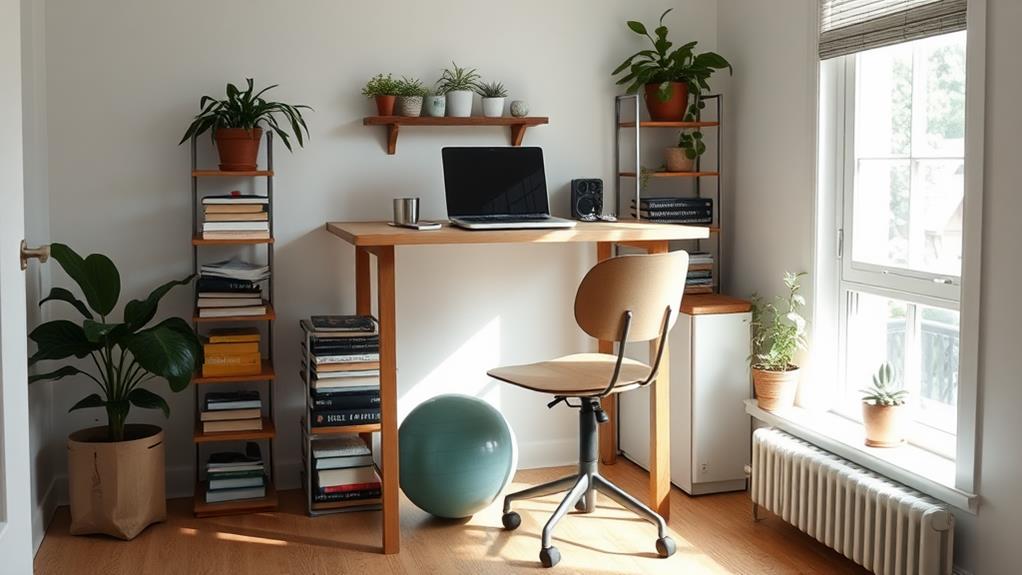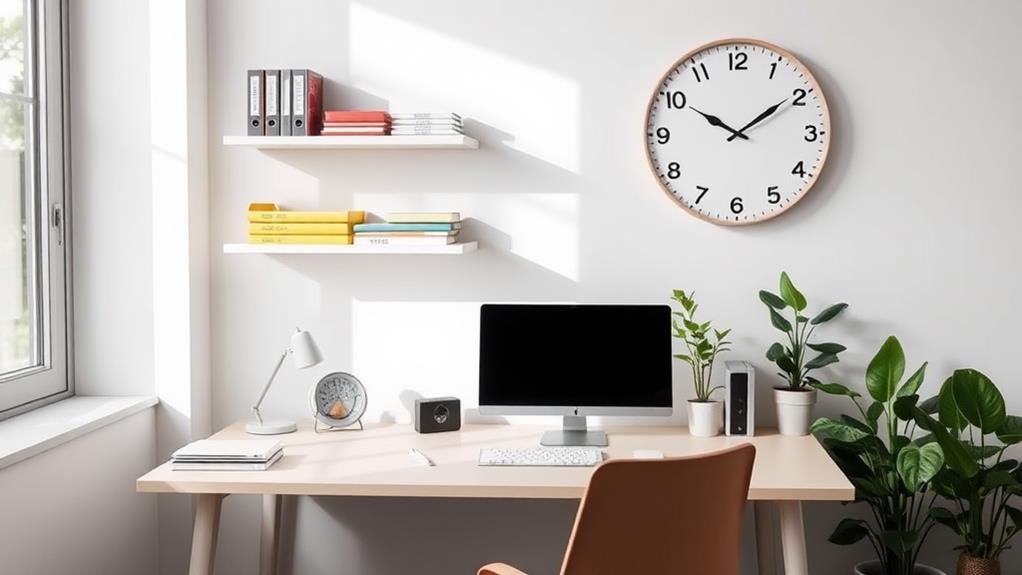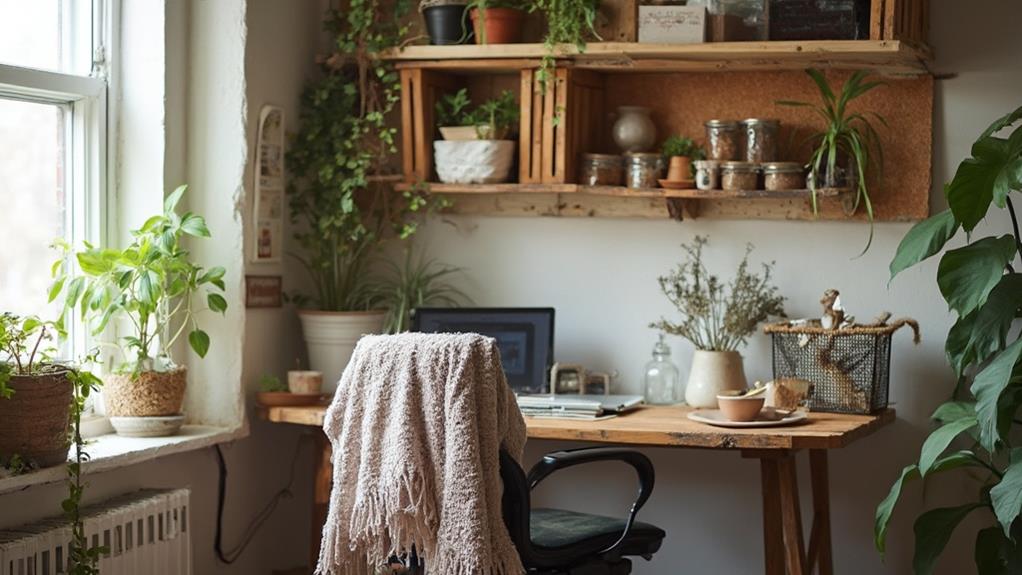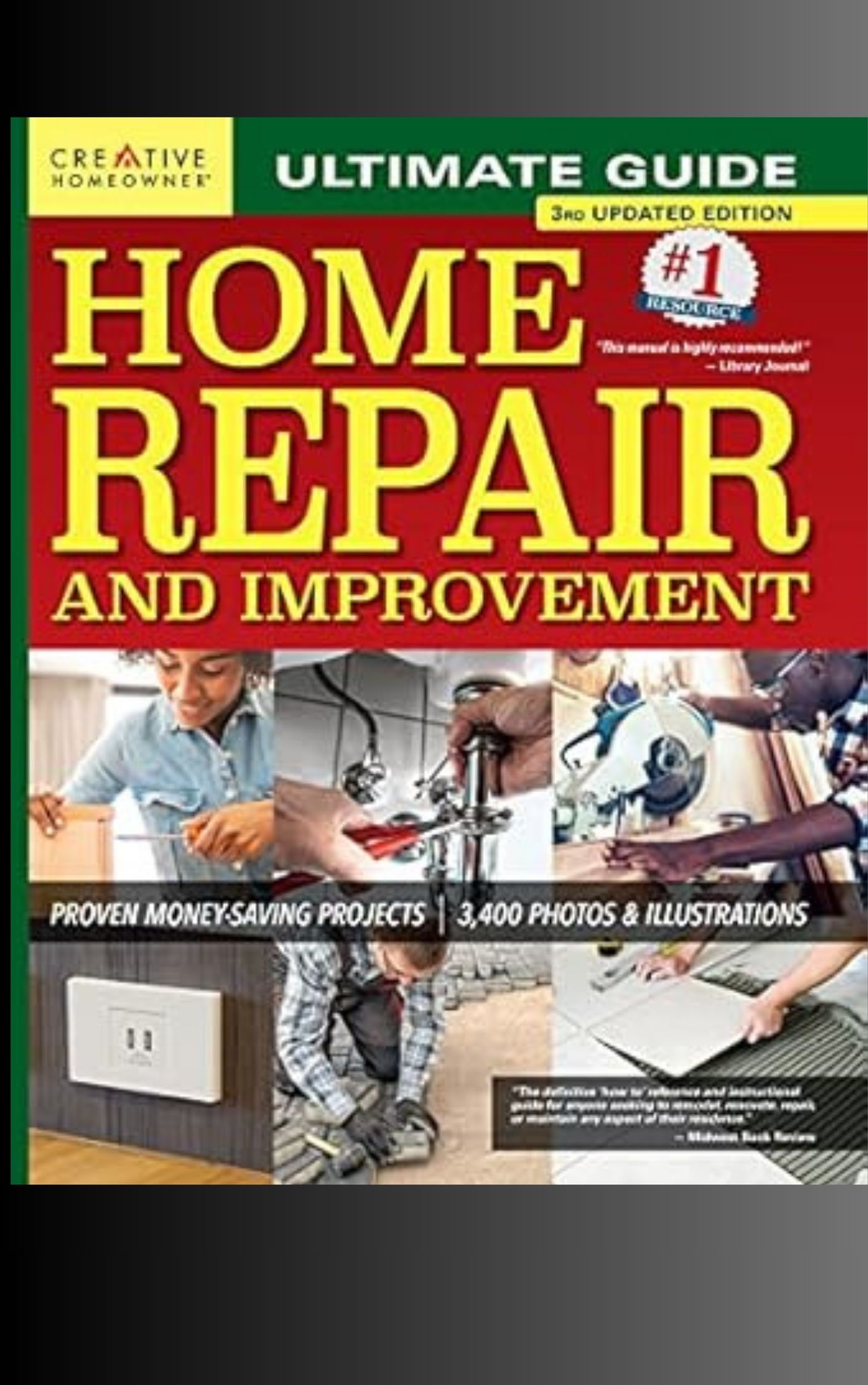Creating a productive home office on a budget is achievable with smart hacks. Optimize lighting by positioning your desk near a window and using a combination of ambient and task lighting. Implement DIY storage solutions like repurposing everyday items or installing floating shelves. Make ergonomic upgrades using household items, such as creating a makeshift wrist rest. Declutter regularly and repurpose household items for unique storage options. Create an inspiring atmosphere with plants and personalized decor. Utilize time management techniques like the Pomodoro method to boost productivity. These simple strategies can transform your workspace without breaking the bank. Discover more ways to maximize your home office efficiency and comfort.
Optimize Your Lighting Setup

How often do we overlook the impact of lighting on our productivity and well-being? Proper lighting in your home office is crucial for reducing eye strain, enhancing focus, and maintaining a positive mood throughout the workday.
To optimize your lighting setup without breaking the bank, start by maximizing natural light. Position your desk near a window, but avoid direct sunlight that can cause glare on your screen.
For artificial lighting, aim for a layered approach. Use a combination of ambient, task, and accent lighting to create a well-balanced environment. Invest in a good desk lamp with adjustable brightness and color temperature to reduce eye fatigue. LED bulbs are energy-efficient and provide consistent illumination. Consider installing dimmer switches to control light levels throughout the day.
Don't forget about the importance of proper screen brightness. Adjust your computer display to match the ambient light in your room, reducing the contrast between your screen and surroundings. Use the 20-20-20 rule: every 20 minutes, look at something 20 feet away for 20 seconds to give your eyes a break. With these simple tweaks, you can create an optimal lighting setup that enhances your productivity and comfort in your home office.
DIY Storage Solutions
Clutter can quickly become the nemesis of productivity in a home office. Implementing DIY storage solutions can help maximize space and maintain organization without breaking the bank. Repurpose everyday items to create functional storage: use mason jars for pens and small office supplies, or transform tin cans into stylish desk organizers with a coat of paint. Install floating shelves to utilize vertical space and keep frequently used items within reach.
Create a pegboard system for versatile storage options. Hang tools, cables, and accessories using hooks and small baskets. Repurpose an old ladder as a unique bookshelf or file storage unit. Utilize the space under your desk by attaching wire baskets or small drawers to the underside. Transform shoe organizers into wall-mounted storage for office supplies, documents, or tech gadgets.
Upcycle wooden crates into modular storage units that can be stacked or mounted on walls. Use tension rods in drawers to create dividers for better organization. Repurpose old file cabinets with a fresh coat of paint and new hardware for a budget-friendly storage upgrade. These DIY solutions offer practical and customizable options to keep your home office organized and clutter-free.
Ergonomic Upgrades on a Budget

While organizing your home office is important, ensuring comfort and proper posture is equally vital for long-term productivity and health. Fortunately, there are several budget-friendly ergonomic upgrades you can implement to improve your workspace.
Start by adjusting your existing chair for proper lumbar support. Use a rolled-up towel or small pillow to provide lower back cushioning if needed. Ensure your feet are flat on the floor; if not, use a footrest or stack of books to achieve the correct height.
Position your computer monitor at eye level to reduce neck strain. A simple DIY monitor stand can be created using sturdy books or a wooden shelf.
For wrist support, create a makeshift wrist rest using a small towel or foam pipe insulation. Invest in an inexpensive keyboard tray to achieve the proper typing angle. To combat eye strain, implement the 20-20-20 rule: every 20 minutes, look at something 20 feet away for 20 seconds. Consider using a desk lamp for task lighting to reduce eye fatigue.
Lastly, incorporate standing breaks by creating a temporary standing desk using a sturdy box or stack of books on your existing desk.
Declutter for Maximum Efficiency
To achieve peak productivity in your home office, decluttering is an essential step that cannot be overlooked. A tidy workspace promotes focus and efficiency, allowing you to concentrate on your tasks without distractions. Begin by removing unnecessary items from your desk, keeping only the essentials within arm's reach. Implement a paperless system by digitizing documents and utilizing cloud storage solutions to reduce physical clutter.
Organize your remaining items using affordable storage solutions like desk organizers, drawer dividers, and file folders. Label everything clearly to maintain order and save time searching for materials. Establish a daily routine of clearing your desk at the end of each workday, ensuring a fresh start the following morning. Regularly assess your office supplies and equipment, disposing of or donating items you no longer need.
Create designated spaces for different activities, such as a reading nook or brainstorming area, to maximize the functionality of your home office. By maintaining a clutter-free environment, you'll not only boost your productivity but also create a more inviting and stress-free workspace that encourages creativity and focus.
Repurpose Household Items

With a bit of creativity, everyday household items can be transformed into practical home office solutions, saving both money and space. A sturdy wooden ladder can become a unique shelving unit for books and supplies, while mason jars serve as stylish organizers for pens, pencils, and other small office tools. Repurpose an old door or reclaimed wood as a spacious desktop, supported by filing cabinets or sawhorses for a rustic yet functional workspace.
Utilize vintage suitcases as storage containers for documents or craft supplies, doubling as decorative elements. Transform a pegboard into a customizable wall organizer for tools, notes, and accessories. Repurpose kitchen utensil holders as cable management solutions, keeping cords tidy and accessible. Use decorative teacups or small planters as catch-all containers for paper clips, rubber bands, and other small office items. Convert an old dresser into a printer stand with built-in storage drawers for paper and ink cartridges. By thinking outside the box and repurposing common household items, you can create a unique, functional home office space without breaking the bank.
Create an Inspiring Atmosphere
A well-designed workspace can significantly boost productivity and creativity. To create an inspiring atmosphere in your home office, focus on elements that stimulate your senses and motivate you.
Start by maximizing natural light, which improves mood and energy levels. If possible, position your desk near a window or use daylight-mimicking bulbs.
Incorporate plants to purify the air and add a touch of nature. Low-maintenance options like succulents or peace lilies work well. Consider a color scheme that promotes focus and creativity; blues and greens are known to enhance productivity, while yellow can spark innovation.
Personalize your space with meaningful artwork, photos, or inspirational quotes. These visual cues can serve as motivation during challenging tasks. Organize your workspace to minimize clutter, as a tidy environment can lead to clearer thinking. Use vertical space with floating shelves or wall organizers to keep your desk uncluttered.
Time Management Techniques

While creating an inspiring atmosphere sets the stage for productivity, effective time management is the key to maximizing your work output. Implement proven techniques to optimize your workday and boost efficiency.
Start by prioritizing tasks using the Eisenhower Matrix, categorizing them into urgent/important, important/not urgent, urgent/not important, and neither urgent nor important.
Utilize the Pomodoro Technique to maintain focus and prevent burnout. Work in 25-minute intervals, followed by short breaks. This method helps sustain concentration and reduces mental fatigue. Time-block your schedule, allocating specific periods for different tasks or projects. This approach minimizes context-switching and enhances productivity.
Adopt the "eat the frog" principle by tackling your most challenging or important task first thing in the morning. This strategy ensures you address critical responsibilities when your energy levels are highest. Minimize distractions by using website blockers, silencing notifications, and establishing clear boundaries with household members.
Regularly assess and adjust your workflow to identify areas for improvement. By implementing these time management techniques, you'll optimize your home office productivity without incurring additional expenses.
Frequently Asked Questions
How Can I Soundproof My Home Office Without Major Renovations?
To soundproof your home office without major renovations, consider using acoustic panels, weatherstripping for doors, heavy curtains, and area rugs. White noise machines or sound-masking devices can also help reduce external noise and create a more focused environment.
What Are the Best Plants for Improving Air Quality in a Home Office?
For improving air quality in a home office, consider these plants: Spider plants, Peace lilies, Snake plants, Bamboo palms, and Pothos. These species are known for their air-purifying properties, removing common indoor pollutants and increasing oxygen levels efficiently.
How Can I Create a Professional Background for Video Calls?
To create a professional background for video calls, consider using a plain wall, hanging a simple backdrop, or arranging a tidy bookshelf behind you. Ensure good lighting and remove any distracting elements from the frame.
What's the Ideal Temperature for Maintaining Productivity in a Home Office?
When it comes to productivity, keeping your cool is key. The ideal temperature for a home office typically ranges between 68-72°F (20-22°C). This range promotes comfort and mental alertness, enhancing focus and work efficiency throughout the day.
How Do I Balance Work and Family Life When Working From Home?
Balancing work and family life when working from home requires clear boundaries and effective time management. Set designated work hours, create a dedicated workspace, communicate expectations with family members, and prioritize self-care to maintain a healthy work-life balance.
Conclusion
Implementing these home office hacks can transform even the most mundane space into a productivity powerhouse. By optimizing lighting, crafting innovative storage solutions, and prioritizing ergonomics, a highly efficient workspace emerges. Decluttering, repurposing, and creating an inspiring atmosphere further enhance focus and creativity. When combined with effective time management techniques, these strategies can catapult productivity to stratospheric levels. With minimal financial investment, a professional-grade home office becomes attainable, proving that a Fortune 500-worthy workspace is possible on a shoestring budget.

